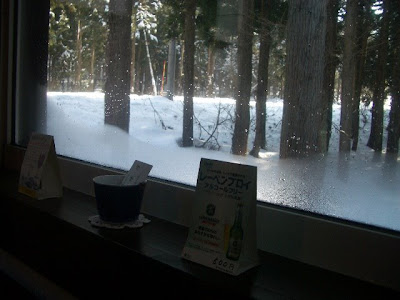I don't feel very well these days, partly because of the stubborn coughs that never seem to go away. So, my lunch on February 2 was a very, very simple one: One stick of gyoniku sausage (fishmeat sausage) and one cup of instant soba (buckwheat noodles).
最近、調子があまり良くないです。いつ終わるか分からない、しつこい咳のせいで。なので、2月2日の昼食は非常に簡単なものでした。魚肉ソーセージ1本とインスタントそばを一杯。
Both of them are very common foodstuffs in Japan, but may be of interest to international readers.
ともに日本ではありふれた食べ物ですが、海外の人には興味深いかも知れません。
Gyoniku sausage looks like this:
魚肉ソーセージとはこんなものです。

It's made of fish meat, starch, and other ingredients.
魚肉、でんぷんなどの素材からできています。
This particular product is sealed at both ends with "eco clips", instead of conventional metal ones, to eliminate the need for sorted collection at the time of disposal.
この製品は両端が、従来の金属クリップではなく「エコクリップ」で閉じられています。捨てる際に分別収集をする手間を省くためです。

One thing I wonder about gyoniku sausage is that it's not liked by many non-Japanese people because of its texture and for other reasons. I don't know proper words to describe the texture. Maybe "mealy" should be the right word.
魚肉ソーセージについて不思議に思うことは、食感のせいで、また他の理由で多くの外国人には好まれていないということです。その食感をどう表現したらいいか分かりませんが、mealy(パサパサした)という言葉が合ってるのかも知れません。
Anyway, I like gyoniku sausage!
とにかく、私は魚肉ソーセージが好きです!

The instant soba that I had was "Midori no Tanuki" (Green Raccoon Dog). In the context of soba, tanuki refers to tiny tempura balls, not the animal.
食べたインスタントのそばは「緑のたぬき」です。そばに関しては、たぬきとは動物のことではなく、小さな天ぷらの玉(天かす、揚げ玉)のことです。

This particular product offers a disk-like tempura, not regular tiny tempura balls.
この製品は通常の小さな天ぷらの玉ではなく、円盤形の天ぷらが入っています。

An interesting fact about this product is that three types of it are sold in their respective regions (Eastern Japan, Western Japan, and Kinki region (including Osaka, Kyoto, and Hyogo).
This one in the photo is for Eastern Japan, and the broth is just too salty for me, even though I was born and bred in Tokyo in Eastern Japan.
この製品の面白いことは、3つのタイプがそれぞれの地域(東日本、西日本、近畿地方)で売られていることです。
写真のは東日本用で、スープが私にはしょっぱ過ぎます。私は東日本の東京で生まれ育ったのですが。

In general, foods and dishes in Eastern Japan are saltier than those in Western Japan.
一般的に東日本の食べ物、料理のほうが、西日本より塩辛いです。










































